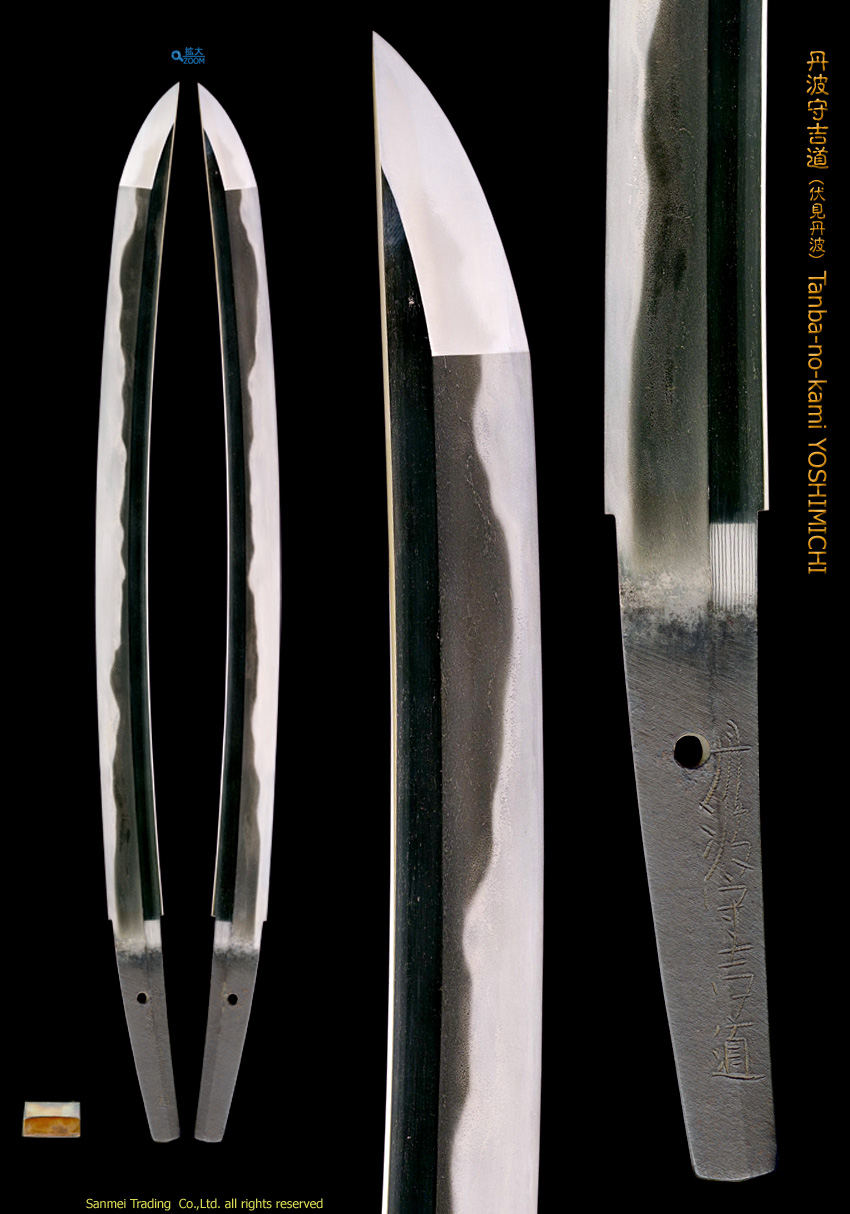Length of cutting edge 47.9cm Curvature 1.3cm Width of base 32.1mm Width of Yokote 28.2mm Thickness of base 6.8mm
Forging(Hada) : Jigane steel is finely-kneaded Ko-Itame-hada appears on Hiraji and conspicuous Masame indication on Shinogi-ji surface. Sparkling martensite crystals Ji-nie appears against fine Ko-Itame to generate precise gleaming lines of Jet-black luster Chikei appearance over the Hiraji surface in light.
Temper(Hamon) : Hamon is rather on stronger side martensite crystals of Nie based, starts with shallow Yakidashi on base, undulating Notare with large Gunome. Upper the blade, it becomes stronger/brighter the Nie where abundant activities of Kinsen and Sunagashi as well as isolated Yubashiri or Tobiyaki to form Sudare-ha like a reed screen. Some isolated quenching area Yubashiri appears on Shinogi-ji and also along back ridge of Mune. Boundary line glows bright with martensite crystals of Nie and deep in the Nioi mist-like crystalline area.
Temper of tip(Boshi): Boshi form irregular Midarekomi, wide in temper to form burst of flame, medium circle turns back deep to form Muneyaki.
Tang(Nakago) : UBU in original.shallow double-bevelled Kurijiri heel. Yasurime is greatly slanting left Ō-sujikai. Back ridge of Nakago is flat with Katte-sagari filemark. One peg hole of Mekugi-ana. The signature inscription in front is located along Shinogi-suji ridge, starts with the an official district title Tanba-no-kami 丹波守 then the name of smith YOSHIMICHI 吉道.
The famed sword artisan Tanba-no-kami YOSHIMICHI 丹波守吉道, known as a third son of KANEMICHI 兼道 in Mino domain. In Eiroku 2 (1559), he went up to Kyoto along with his brothers, elder brother Iga-no-kami KIN'MICHI 伊賀守金道, second brother Izumi-no-kami KIN'MICHI 和泉守金道 and younger brother E'chu-no-kami MASATOSHI 越中守正俊.
He enjoyed an official district Tanba-no-kami 丹波守 title in Bunroku 4 (1595), died in 2nd day, 1st month Gen'na 5 (1619).
The subject Tanba-no-kami YOSHIMICHI 丹波守吉道 shows a typical inscription signature waht is called Fushimi Tanba 伏見丹波, so to speak, the 2nd stroke of Tan 丹 is angular lettering and the left-hand side of "ba" 波 forms non-cursive in 3-separate stroke "
The subject wakizashi is traced back to right after he enjoyed Tanba-no-kami 丹波守 title in 1595-00. The shape is created in solidly durable heavy which was ordered by courageous Samurai worrier. Hamon starts with shallow Yakidashi on base and the most dynamic Hamon "Sudare-ha" in extra-brilliant quenching status. In detailed view on Jigane skin, this wakizashi is forged using super fine steel. These feature stands at the dawning of the new Keicho-shinto age.
The Nakago holds excellent taste of patina and remains typical inscription signature in his early years.
Old double layer habaki collar (lower is silver, upper is copper), preserved in Shirasaya plain wood mounting
Excellent polish/Condition scale: mint (using a scale of mint-excellent-very good-good-fair-poor)
reference data : KOJIMA Tsutomu, Touken-Bijutsu vol.610/611, NBTHK, 2007


